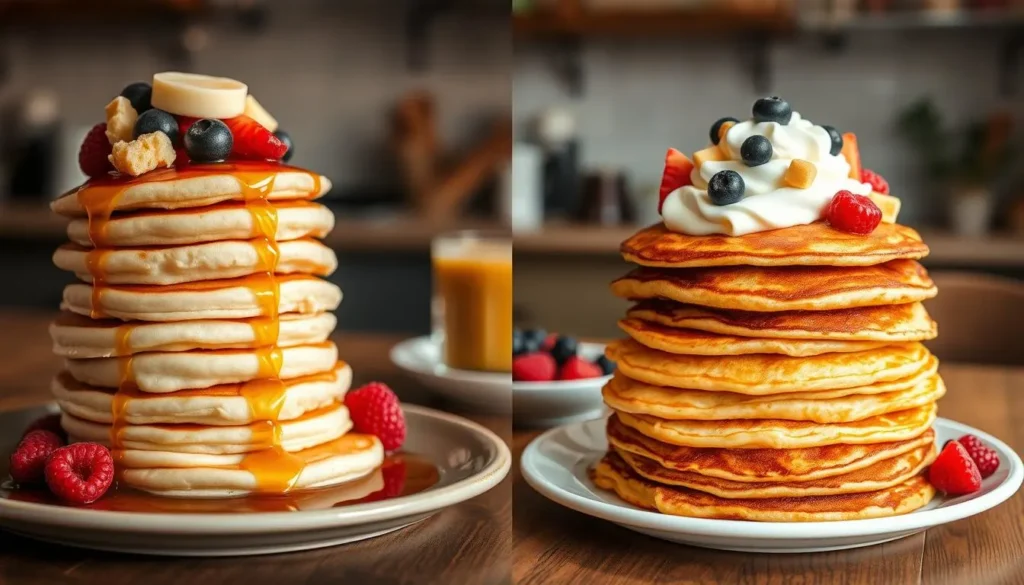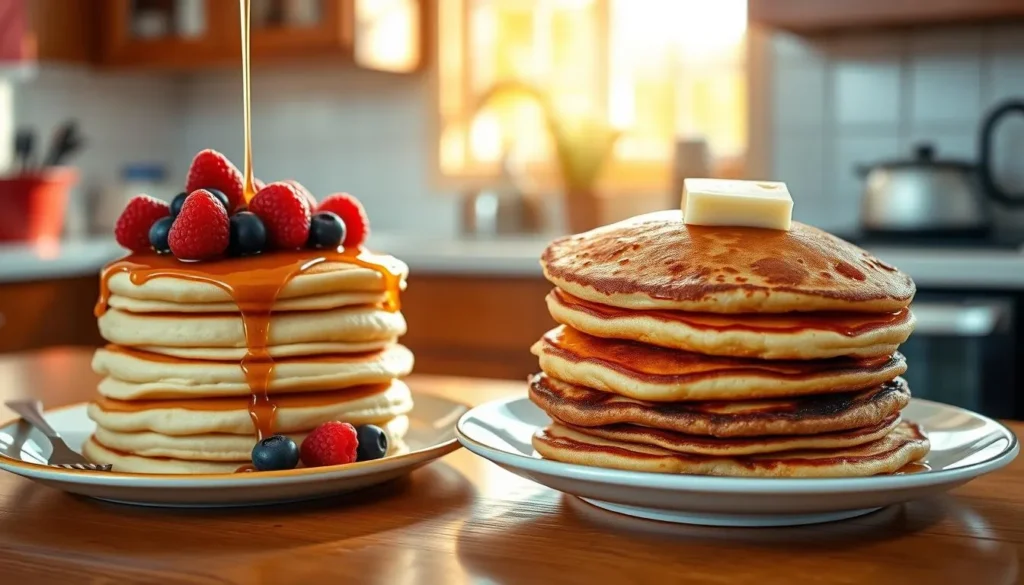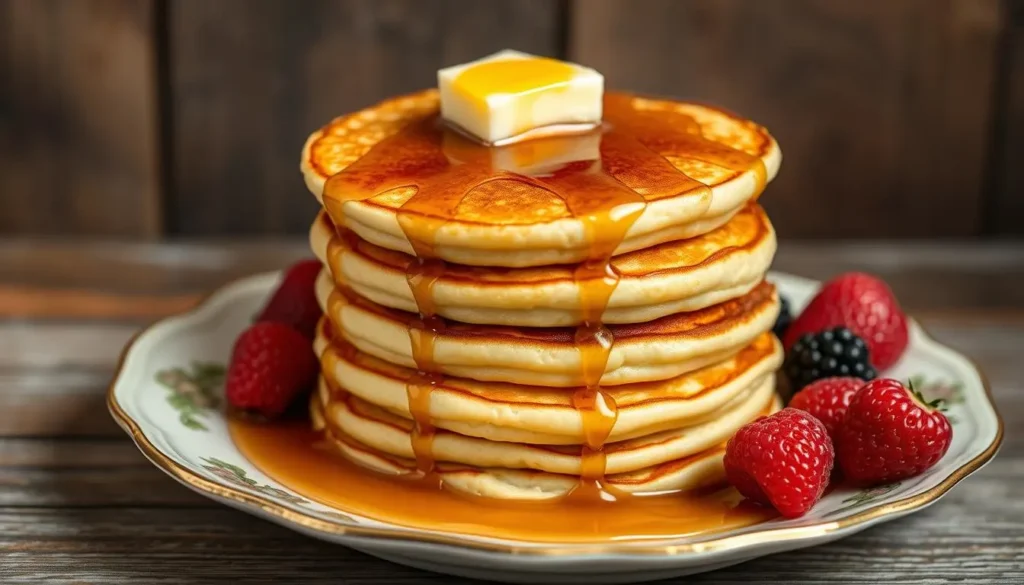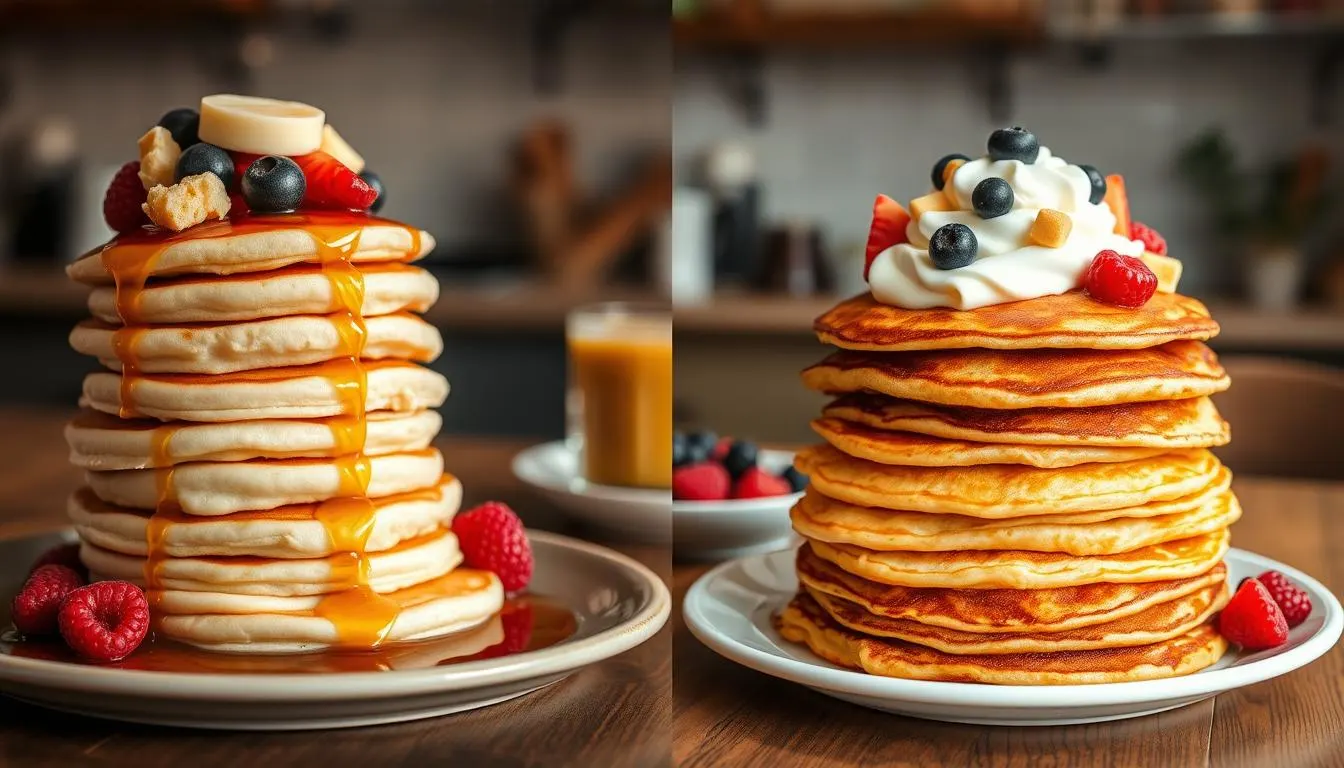Ever looked at a stack of golden, fluffy breakfast treats and wondered, “What’s the difference between pancakes and hotcakes” It’s a question that puzzles many breakfast lovers. The small differences between these two breakfast favorites can be tricky to spot. But don’t worry, we’re about to dive into a culinary journey that will clear up the mystery.
For more recipes check out Breakfast category.

Key Takeaways
- Pancakes and hotcakes are often used interchangeably, but they have subtle differences in their origins and preparation.
- Pancakes have a longer history, with origins dating back to ancient Greece, while hotcakes are more closely associated with American culinary traditions.
- Terminology and serving styles can vary greatly depending on regional and cultural influences.
- Understanding the unique characteristics of each breakfast item can enhance your appreciation and enjoyment of these delectable delights.
- Exploring the nuances between pancakes and hotcakes can lead to a deeper understanding of our shared culinary heritage.
Understanding the Origins of Pancakes and Hotcakes
Pancakes and hotcakes are loved by many, with a history that goes back to ancient times. These dishes have been important in cultures around the world. Their names and ways of making them have changed over time.
Historical Evolution of Flatbreads
The start of pancakes and hotcakes is tied to flatbreads, which were among the first foods baked by humans. The Greeks and Romans cooked simple dough on hot stones or metal plates as far back as the 5th century BC.
Cultural Significance Across Different Regions
Hotcake definition dishes are a big part of many cultures. From France’s crepes to India’s dosas, these griddle cakes have been loved everywhere. They show how batter-based dishes are enjoyed by people all over.
Etymology and Naming Conventions
The names for these griddle cooking treats have changed over the years. “Pancake” comes from the Greek “tagenias,” meaning a thin cake cooked in a pan. “Hotcake” is often used the same way as “pancake,” showing how these names can shift.
“Pancakes and hotcakes have been a beloved part of many cultures for centuries, reflecting the enduring appeal of these simple yet delicious batter-based dishes.”

What’s the difference between pancakes and hotcakes?
Pancakes and hotcakes are breakfast favorites that people often mix up. But, they have some key differences. Let’s look at what makes pancakes and hotcakes unique.
Pancakes come from North America, brought by early settlers from Europe. Hotcakes, on the other hand, are a favorite in the southern United States. They have been loved for generations.
Even though they come from different places, pancakes and hotcakes are similar. They both use a batter of flour, eggs, milk, and baking powder or soda. This batter is cooked on a hot griddle until it’s golden brown.
| Pancakes | Hotcakes |
|---|---|
| Originated in North America | Originated in the southern United States |
| Tend to be thinner and lighter in texture | Tend to be thicker and more dense in texture |
| Commonly served with a variety of toppings, such as syrup, fruit, or whipped cream | Often enjoyed with traditional southern toppings, such as butter and syrup |
The main difference between pancakes and hotcakes is where they come from and the traditions around them. Whether you like the fluffy pancakes of the north or the thick hotcakes of the south, both are great for breakfast.
“Pancakes and hotcakes may have different names, but they’re both delicious ways to start your day.”
Basic Ingredients Used in Pancake Making
Making delicious pancakes or hotcakes needs careful picking of ingredients. At the core of these dishes are a few key parts that work together. They create the perfect texture and taste. Knowing these ingredients is key for tasty pancakes.
Essential Pancake Components
The base of any pancake recipe includes a few must-haves:
- Flour – It’s the main ingredient that gives pancakes their shape and texture.
- Eggs – Eggs act as a binder, keeping the batter together and adding richness.
- Milk or Buttermilk – These liquids add moisture and make the batter smooth.
- Butter or Oil – A bit of fat is used to grease the pan, so pancakes don’t stick.
- Sugar – A little sweetness, like granulated or brown sugar, boosts the flavor.
- Baking Powder or Baking Soda – These agents make pancakes light and fluffy by releasing bubbles.
Optional Add-ins and Variations
There’s a lot you can add to pancake recipes to make them your own. Home cooks and chefs often try new ingredients to create unique pancakes. Some favorites include:
- Fresh or Frozen Fruit (e.g., blueberries, bananas, apples)
- Chocolate Chips or Cocoa Powder
- Nuts and Seeds (e.g., chopped pecans, walnuts, or chia seeds)
- Spices (e.g., cinnamon, nutmeg, vanilla extract)
- Savory Ingredients (e.g., bacon, cheese, herbs)
Role of Leavening Agents
Leavening agents like baking powder or baking soda are vital for pancake texture and look. They release bubbles that make the batter rise, creating a light, airy pancake. The right amount ensures pancakes are fluffy and tender, not dense.
“The secret to making the perfect pancakes is all in the batter. Get the right balance of ingredients, and you’re on your way to a stack of fluffy, golden-brown perfection.”
Traditional Hotcake Preparation Methods
Creating delicious griddle cooking for your breakfast foods and morning meals starts with traditional hotcake methods. These methods are the base for making fluffy, golden-brown hotcakes that will make your taste buds happy.
Using a griddle or skillet is key in traditional hotcake making. These cooking tools, often made of cast iron or heavy-duty metal, spread heat evenly. This is crucial for getting the right sear and texture on your hotcakes.
- Preheat your griddle or skillet over medium heat, letting it get ready for griddle cooking.
- Lightly grease the surface with oil or butter to prevent sticking and get a golden-brown crust.
- Carefully pour the hotcake batter onto the preheated surface, aiming for the right size and thickness.
- Keep an eye on the temperature, adjusting it as needed to keep the perfect cooking environment for your breakfast foods.
- Flip the hotcakes gently with a spatula when the edges start to set and the centers are no longer wet, showing a beautiful golden-brown underside.
- Keep cooking until the hotcakes are fully cooked, with a light, fluffy texture and a wonderful aroma.
| Technique | Purpose |
|---|---|
| Preheating the Griddle | Ensures even heat distribution for consistent cooking. |
| Greasing the Surface | Prevents sticking and promotes a crispy, golden-brown exterior. |
| Proper Batter Portioning | Allows for consistent size and thickness of the morning meals. |
| Temperature Monitoring | Maintains the ideal cooking environment for griddle cooking. |
| Gentle Flipping | Preserves the delicate texture and structure of the breakfast foods. |
By mastering these traditional griddle cooking techniques, you can make your breakfast foods and morning meals even better. You’ll serve up a truly delightful dining experience.

Regional Variations in Terminology and Style
Pancakes and hotcakes may seem similar, but they differ a lot in how they’re made and served. Across America and around the world, these breakfast foods show the rich variety of culinary traditions. They highlight the cultural diversity in how we enjoy our meals.
American Pancake Traditions
In the United States, pancakes are a big hit on brunch menus. They’re a favorite in breakfast foods. You’ll find fluffy buttermilk pancakes in the South and thin hotcakes in the Northeast. Everywhere, you can enjoy towering stacks with many toppings.
International Interpretations
Outside the U.S., pancakes and similar dishes have their own unique tastes and textures. In France, you’ll find crêpes, while in India, there are savory dosas. The world’s cuisines have made these breakfast foods their own, adding their special touches.
Commercial vs. Homemade Versions
The line between pancakes and hotcakes gets fuzzy when comparing store-bought and homemade. Commercial mixes aim for a uniform, fluffy texture. But homemade pancakes let cooks add their own creativity and personal touch.
“Pancakes and hotcakes are not just breakfast foods – they are a reflection of the diverse culinary traditions that shape our world.”
Cooking Techniques and Equipment
In the world of griddle cooking, secrets to great pancakes and hotcakes are in techniques and tools. Whether you’re a pro chef or a home cook, learning griddle cooking can make your pancake recipe and other dishes better.
The right pan or griddle is key for perfect pancakes. Cast-iron skillets and non-stick griddles are top picks because they heat evenly and release batter well. The size and shape of your cooking area also matter, as bigger griddles let you cook more pancakes at once.
Keeping the right temperature is vital for griddle cooking. For pancake recipe and other dishes, aim for 350°F to 375°F. This ensures the pancake cooks evenly on the outside and stays fluffy inside.
- Invest in a high-quality griddle or non-stick pan for the best results.
- Preheat your cooking surface thoroughly before adding the batter.
- Use a ladle or measuring cup to portion the batter for consistent shapes and sizes.
- Avoid crowding the pan or griddle, as this can lead to uneven cooking.
Technique also plays a big role. Pouring batter gently onto the hot surface helps avoid air pockets and makes the texture even. Let pancakes cook until edges are set before flipping for a golden exterior and fluffy inside.
Mastering the right griddle cooking techniques and using the right tools can take your pancake recipe and other dishes to the next level. Try different methods and tools to find what works best for you and your kitchen.
Texture and Consistency Comparisons
Pancakes and hotcakes differ in texture and consistency. These differences make each dish unique. Factors like thickness, density, and surface play a big role.
Thickness and Density Factors
Pancakes are thinner and more delicate than hotcakes. Their batter is more liquid, making them light and airy. Hotcakes, with thicker batter, are denser and more substantial.
Surface Characteristics
Pancakes have a smooth, browned surface and a soft inside. Hotcakes have a varied surface, with a crisper edge and a softer center.
| Characteristic | Pancakes | Hotcakes |
|---|---|---|
| Thickness | Thinner | Thicker |
| Density | Lighter, airier | Heartier, more substantial |
| Surface | Smooth, evenly browned | More varied, slightly crisper edges |
Knowing the differences in texture and consistency between pancakes and hotcakes helps us enjoy their unique qualities.
Serving Suggestions and Popular Toppings
Pancakes and hotcakes are great for breakfast or brunch. They can be made in many ways. You can choose from sweet or savory toppings.
Maple syrup is a classic choice. It’s sweet and goes well with the cakes. For something more filling, try bacon, sausage, or ham on top.
- Fresh fruit like bananas, berries, or apples adds a nice touch. It’s healthy and refreshing.
- Whipped cream, chocolate chips, or powdered sugar make pancakes extra special. They’re perfect for brunch.
- For a bigger meal, try cheese, sautéed veggies, or a fried egg on your pancakes.
In different places, pancakes might have special toppings. In the American South, you might find pecan butter or fruit compote on top.
| Topping | Description | Flavor Profile |
|---|---|---|
| Maple Syrup | A classic, sweet topping that complements the fluffy texture of pancakes. | Sweet |
| Whipped Cream | An indulgent topping that adds a creamy, rich element to pancakes. | Creamy, sweet |
| Sliced Bananas | A fresh, nutritious addition that provides a natural sweetness. | Sweet, fruity |
| Sautéed Vegetables | A savory option that can transform pancakes into a more substantial meal. | Savory, Umami |
There are countless ways to enjoy pancakes or hotcakes. They make for a tasty and fulfilling breakfast or brunch.
Common Mistakes in Making Pancakes and Hotcakes
Making pancakes and hotcakes might seem easy, but even pros can run into problems. Getting the griddle temperature right and the batter consistency are key. These factors can greatly affect your pancake recipe.
Temperature Control Issues
One big mistake is not keeping the griddle at the right temperature. If it’s too hot, the pancakes burn before they’re fully cooked. If it’s too cold, they stay soggy. Aim for a temperature between 350°F and 375°F for perfect pancakes.
Batter Consistency Problems
Getting the batter just right is crucial for light pancakes. Overmixing makes them tough, while undermixing leads to lumps. Mix the wet and dry ingredients gently until they’re just combined. The batter should pour smoothly but not be too thin or thick.
By focusing on temperature and batter consistency, you can make great pancakes and hotcakes at home.
| Common Mistake | Potential Cause | Solution |
|---|---|---|
| Burnt exterior, undercooked interior | Cooking at too high temperature | Maintain temperature between 350°F and 375°F |
| Soggy, dense pancakes | Cooking at too low temperature | Increase cooking temperature to 350°F-375°F |
| Lumpy, uneven batter | Undermixing the ingredients | Gently mix the batter until just combined |
| Tough, dense pancakes | Overmixing the batter | Avoid over-mixing the batter |
Health and Nutritional Considerations
Pancakes and hotcakes are tasty, but we should think about their health impact. They can be high in calories, carbs, and fats, depending on what’s in them. But, making a few changes can make them healthier.
The number of calories in pancakes and hotcakes can change a lot. They can have between 200 to 400 calories per serving, based on size and toppings. To make them better, try using whole-grain flour and less sugar. Choose olive oil or Greek yogurt instead of butter. Adding fresh fruit like berries or bananas can also add nutrients and sweetness.
Even though pancakes and hotcakes aren’t the healthiest breakfasts, they can still fit into a healthy diet. By picking the right ingredients and portion sizes, you can enjoy them as part of a balanced diet. Make sure to pick breakfast foods and morning meals that are varied. And think about the pancake ingredients to make your favorite breakfast treat healthier.
Related : Easy Homemade Hotcake Mix Recipe | Perfect Breakfast
FAQ
What’s the difference between pancakes and hotcakes?
Pancakes and hotcakes are the same dish, with different names in different places. They are batter-based, cooked on a griddle, but the names vary by region.
What is the definition of a hotcake?
A hotcake is a type of pancake cooked on a griddle or skillet. It’s called a hotcake in some parts of the United States.
What are the basic ingredients used to make pancakes?
Pancakes need flour, baking powder, sugar, salt, milk, eggs, and melted butter or oil. You can also add vanilla, cinnamon, or fruit for extra flavor.
How are hotcakes traditionally prepared?
Hotcakes are cooked on a hot griddle or skillet with a bit of oil or butter. Pour the batter on the hot surface. Cook until the edges set and the top bubbles, then flip to cook the other side.
What are the key differences in texture and consistency between pancakes and hotcakes?
Pancakes and hotcakes can differ in texture and consistency. Pancakes are often thicker and denser. Hotcakes are lighter and airier.
How do regional variations affect the terminology and style of pancakes and hotcakes?
Different regions have their own ways of making pancakes and hotcakes. American traditions may differ from international ones. Homemade versions can also vary from store-bought ones.
What are some common mistakes to avoid when making pancakes or hotcakes?
Avoid issues with temperature and batter consistency. A griddle that’s too hot or too cold, and batter that’s over- or under-mixed, can ruin your pancakes or hotcakes. Paying attention to these details is key.
What are the health and nutritional considerations for pancakes and hotcakes?
Pancakes and hotcakes can be part of a healthy diet if made right. They can be high in calories and carbs, especially with unhealthy fats. Using whole-grain flours and plant-based milks can make them healthier.

